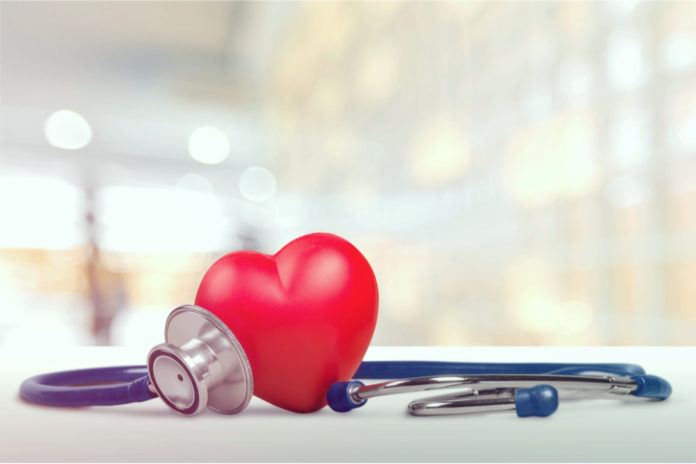More than 1 in 10 American adults have been diagnosed with heart disease. Cardiovascular disease also accounts for 1 in 3 deaths in the United States!
Fortunately, spotting early signs of heart disease and taking preventative measures can help lower these statistics. And what better time than American Heart Month (each February) to raise awareness and brush up on prevention and treatment options?
Read on to learn how to take care of your heart during heart health month and throughout the entire year!
What Is Cardiovascular Disease?
Cardiovascular disease, also known as heart disease, affects the hardest working muscle in the body. Heart disease causes damage to the heart and blood vessels.
A big umbrella term, cardiovascular disease describes the following types of conditions:
- Blood vessel disease (i.e. coronary artery disease)
- Stroke
- Heart rhythm problems (arrhythmias)
- Heart defects one is born with (congenital heart defects)
- Disease or infection of the heart muscle
- Heart valve disease
Coronary Heart Disease
Coronary heart disease, also called coronary artery disease, causes plaque to build up. Plaque is a combination of fat, cholesterol, calcium, and other substances that build up in the arteries.
Clogged arteries or atherosclerosis are both other names for plaque. Plaque is a problem because it decreases the amount of oxygen-rich blood that can get to the heart.
Heart Attack
A heart attack can occur when a blood clot cuts off blood flow to the heart. While most people survive their first heart attack, the return to normal life depends on the degree of damage.
Doctor recommended therapies usually include a combination of physical activity recommendations, medications, diet suggestions, and lifestyle changes.
Stroke
Similar to a heart attack, a stroke happens when blood vessels get blocked or bursts. In cases of stroke, the vessels feed the brain instead of the heart muscle. A clot cutting off supply to the brain can cause brain cells to die.
Damage can range from temporary to permanent depending on how long the brain was starved of oxygen. This is why catching the early signs and knowing the symptoms is so significant.
Symptoms & Early Signs of Heart Disease
The earlier the signs and symptoms of heart disease are caught, the better. Regularly getting evaluated and discussing concerns with a cardiologist or doctor just might end up saving a life.
The following 5 signs are commonly overlooked symptoms of heart disease:
- Fatigue
- Aches and pains
- Sensation of shortness of breath
- Swelling, especially in the feet or ankles
- Irregular or rapid heartbeat
Symptoms of a Heart Attack
- Shortness of breath
- Pressure in upper chest/abdomen
- Dizziness
- Fainting
- Nausea
- Vomiting
- Pain or discomfort in the arms, back, neck, jaw, or stomach
- Fatigue
Symptoms of Heart Disease in the Blood Vessels
- Chest pain
- Chest tightness
- Chest pressure
- Chest discomfort (angina)
- Pain, numbness, weakness, cold sensation in the legs/arms
- Pain in the neck, jaw, throat, upper abdomen, or back
Symptoms of a Stroke
Strokes result in loss of the functions controlled by the part of the brain being blocked. Signs of stroke can include impaired movement, such as walking, and difficulty talking.
Symptoms of Heart Arrhythmias
- Fluttering feeling in the chest
- Racing or slow heartbeat
- Chest pain
- Chest discomfort
- Sensation of shortness of breath
- Dizzy spells or dizziness
- Fainting or near fainting experiences
Symptoms of Heart Defects
- Pale or blue skin
- Swelling of the legs, abdomen, or eye area
- Shortness of breath
- Difficulty with exercise or activity
- Easily getting exhausted with exercise or activity
- Swelling of the hands, ankles, or feet
Symptoms of Disease in the Heart Muscle
- Breathlessness with activity or rest
- Swelling of the extremities (i.e. legs, ankles, or feet)
- Fatigue
- Irregular heartbeats
- Dizziness
- Fainting
Symptoms of Heart Infection
- Fever
- Shortness of breath
- Weakness
- Fatigue
- Swelling of chest or abdomen area
- Changes in heartbeat
- Dry or persistent cough
- Skin rash or the appearance of unusual spots
Symptoms of Heart Valve Problems (Vascular Disease)
- Fatigue
- Shortness of breath
- Irregular heartbeat
- Swelling of the feet or ankles
- Chest Pain
- Fainting
It Might Look Different in Women
Heart health is often thought of as a “men’s problem”. However, it is the leading cause of death for women in the United States and responsible for about 1 in 4 deaths per year.
Women often ignore symptoms until an emergency arises. Symptoms such as changes in skin color or sweating may seem subtle but can be signs of a heart attack.
Cardiac events and symptoms can occur both at rest and during daily life activities. It is better safe than sorry when it comes to reporting concerning, even seemingly mild, symptoms to the doctor.
Here are some common symptoms of heart disease in women:
- Weight gain
- Sleeping disturbances
- Irregular heartbeat
- Coughing
- Wheezing
- Sweating
- Lightheadedness
- Indigestion
- Heartburn
- Anxiety
- Fainting
How to Prevent Heart Disease
Small and consistent efforts can help protect the heart. For example, the risk of heart disease can drop in as little as one day after quitting smoking.
Intentional shifts such as stopping smoking can have a positive domino effect. Reducing blood pressure and cholesterol levels are key steps to returning to a healthier lifestyle and better preventing heart disease.
Routine Health Screenings
Regularly meeting with a doctor and other health providers as recommended can help catch warning signs before they get too serious.
There are a few conditions and common symptoms to keep an eye on:
- High blood pressure
- High cholesterol levels
- A1C
- Type 2 diabetes
- Injury, infection, or inflammation
- Chest pain
- Shortness of breath
- Fainting or dizziness
- Organ function (i.e. liver, thyroid, kidney)
- Blood cell counts
- Sodium and potassium levels
It is important to manage other health conditions properly. Unmanaged blood pressure, cholesterol or diabetes can worsen heart disease symptoms.
Lifestyle Changes
- Get Physical: Physical inactivity is a risk factor for heart disease. Aim for at least 150 minutes of aerobic activity weekly.
- Maintain a Healthy Weight: Obesity is associated with heart disease and worsening other risk factors. Even small amounts of weight loss, just 3-5%, can help decrease cholesterol, blood sugar, and diabetes risk.
- Prioritize Stress Management– Stress can damage the arteries and worsen other risk factors, leading to heart disease. Drinking, overeating, and smoking are all unhealthy coping mechanisms. Try to find healthy ways to combat stress. For example, physical activity, relaxation exercises, medication, or breathing exercises can be great options for staying balanced.
- Slow Down on the Salt: Focusing on increasing fruit and vegetable intake as well as eating whole grains can significantly reduce risk.
- Stop Smoking & Do Not Use Tobacco: This is a lifestyle factor that can both prevent and improve heart disease. Avoid secondhand smoke. Chemicals in smoke and tobacco can damage the heart and blood vessels by decreasing oxygen in the blood.
- Have Good Sleep Hygiene: Bad sleep is harmful to health. Adults need at least seven hours each night. It is important to express concerns to a doctor if sleep does not feel refreshing. Poor sleeping habits are often a signal of other problems in the body.
Know Your Risk Factors
The following risk factors can increase the risk of developing heart disease:
- Older age
- Being male
- Being a postmenopausal female
- Premature menopause
- Having a family history of heart disease, especially at an early age
- Smoking
- Poor diet (i.e. high in fat, sugar, salt, or cholesterol)
- Diabetes
- Obesity
- Physical inactivity
- Stress, especially chronic stress
- Poor dental health (can lead to infection)
- Inflammatory diseases (i.e. rheumatoid arthritis, lupus)
- HIV
- High blood pressure during pregnancy or gestational diabetes
Treatment Options
Many forms of cardiovascular disease or damage can be treated with healthy habits. Lifestyle choices can be key to preventing or reversing heart disease.
Education
For both the patient and the caregiver, education is crucial. From medications to prevention, from treatment to routine tests, there is a lot of information to keep track of. It is important that the healthcare team is involved and that the patient’s support system is working together.
Eat a Heart Healthy Diet
A healthy diet can improve blood pressure, cholesterol, and diabetes management. Be sure to incorporate the following foods:
- Vegetables
- Fruit
- Beans or other legumes
- Lean meats and fish
- Low-fat or fat-free dairy
- Whole grains
- Healthy fats (i.e. unsaturated, olive oil)
It is also important to limit dietary intake of foods that can worsen high blood pressure, such as:
- Salt
- Sugar, especially added sugar
- Processed carbohydrates
- Alcohol
- Saturated fat (i.e. from red meat, full-fat dairy) and trans fat (i.e. from fried food, chips, baked goods)
Spice It Up
Seasonings such as turmeric, with the bioactive component curcumin, have protective properties. Curcumin has been used for thousands of years to prevent inflammation, and it still proves to show this beneficial function.
Medication
Early detection and treatment of problems with medication can aid in recovery. It can also prevent another cardiac event from occuring.
Surgery
Options for surgery are dependent upon the severity of disease or damage. Surgeries for heart problems can range from minimally invasive procedures to total removal or replacement of damaged tissues.
Talk to a cardiologist familiar with the case to examine what surgery options are available and determine the most appropriate course of action.
The Bottom Line
Overall, knowing the symptoms and taking preventative measures can reduce the impact of heart disease, stroke, amongst other health conditions. Treatment options are also readily available as needed.
So for this heart health month, what will you do to protect the heart and elevate overall health?
References:
American Heart Association. What is Cardiovascular Disease. American Heart Association. 2021. www.heart.org/en/health-topics/consumer-healthcare/what-is-cardiovascular-disease.
Harvard Medical School. 5 overlooked symptoms that may signal heart trouble. Harvard Health Publishing. 2020. www.health.harvard.edu/heart-health/5-overlooked-symptoms-that-may-signal-heart-trouble.
Hersh E. What You Need to Know About Heart Disease in Women. Healthline. 2019. www.healthline.com/health/heart-disease-in-women.
Mayo Clinic Staff. Blood tests for heart disease. Mayo Foundation for Medical Education and Research. 2021. www.mayoclinic.org/diseases-conditions/heart-disease/in-depth/heart-disease/art-20049357.
Mayo Clinic Staff. Heart disease. Mayo Foundation for Medical Education and Research (MFMER). 2021. www.mayoclinic.org/diseases-conditions/heart-disease/symptoms-causes/syc-20353118.
Mayo Clinic Staff. Strategies to prevent heart disease. Mayo Foundation for Medical Education and Research. 2021. www.mayoclinic.org/diseases-conditions/heart-disease/in-depth/heart-disease-prevention/art-20046502.
National Heart, Lung, and Blood Institute. Know the Differences. National Heart Disease. 2021. www.nhlbi.nih.gov/sites/default/files/media/docs/Fact_Sheet_Know_Diff_Design.508_pdf.pdf.








